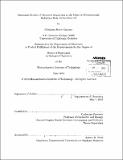| dc.contributor.advisor | Catherine Drennan. | en_US |
| dc.contributor.author | Zimanyi, Christina Marie | en_US |
| dc.contributor.other | Massachusetts Institute of Technology. Department of Chemistry. | en_US |
| dc.date.accessioned | 2013-11-18T19:09:46Z | |
| dc.date.available | 2013-11-18T19:09:46Z | |
| dc.date.copyright | 2013 | en_US |
| dc.date.issued | 2013 | en_US |
| dc.identifier.uri | http://hdl.handle.net/1721.1/82330 | |
| dc.description | Thesis (Ph. D. in Biological Chemistry)--Massachusetts Institute of Technology, Dept. of Chemistry, 2013. | en_US |
| dc.description | Cataloged from PDF version of thesis. Vita. | en_US |
| dc.description | Includes bibliographical references. | en_US |
| dc.description.abstract | Ribonucleotide reductase (RNR) converts ribonucleotides to deoxyribonucleotides, the building blocks for DNA replication and repair. The E. coli class Ia enzyme requires two subunits to catalyze the radical-based reduction reaction. [beta]2 houses a diferric-tyrosyl radical cofactor and [alpha]2 contains the active site and two allosteric effector binding sites. Allosteric control of RNR fine-tunes both the relative ratios (via substrate specificity regulation) and the total amount (via activity regulation) of deoxyribonucleotides (dNTPs) in the cell. The molecular basis of this regulation has been enigmatic, largely due to a lack of structural information about how the [alpha]2 and [beta]2 subunits interact. Here, we present the structure of a complex between the [alpha]2 and [beta]2 subunits in the presence of negative activity effector dATP, revealing an [alpha]4[beta]4 ring-like structure. Using electron microscopy (EM), small-angle X-ray scattering (SAXS), and analytical ultracentrifugation (AUC) we show how activity regulation is achieved by modulating the distributions of active [alpha]2[beta]2 and inhibited [alpha]4[beta]4, an interconversion that requires dramatic subunit rearrangements. The X-ray crystal structure of the dATP-inhibited RNR and a second structure obtained using a mechanism based inhibitor reveal that [alpha]4[beta]4 rings can interlock to form an ([alpha]4[beta]4)2 megacomplex. We use SAXS to understand the solution conditions that contribute to the observed concatenation and present a mechanism for the formation of these unusual structures. We also present the first X-ray crystal structures of [alpha]2 with ATP or dATP bound at both allosteric sites, and discuss how observed differences in their binding influence the modulation between [alpha]2[beta]2 and [alpha]4[beta]4. Finally, we present structures that comprise a full set of cognate substrate/specificity effector pairs bound to the E. coli class Ia RNR. These structures allow us to describe how binding of dNTP effectors at the specificity site promotes binding of a preferred substrate. With these structural data, we describe in molecular detail, how the binding of allosteric effectors influences RNR activity and substrate specificity. | en_US |
| dc.description.statementofresponsibility | by Christina Marie Zimanyi. | en_US |
| dc.format.extent | 274 p. | en_US |
| dc.language.iso | eng | en_US |
| dc.publisher | Massachusetts Institute of Technology | en_US |
| dc.rights | M.I.T. theses are protected by
copyright. They may be viewed from this source for any purpose, but
reproduction or distribution in any format is prohibited without written
permission. See provided URL for inquiries about permission. | en_US |
| dc.rights.uri | http://dspace.mit.edu/handle/1721.1/7582 | en_US |
| dc.subject | Chemistry. | en_US |
| dc.title | Structural studies of allosteric regulation in the class Ia Ribonucleotide reductase from Escherichia coli | en_US |
| dc.type | Thesis | en_US |
| dc.description.degree | Ph.D.in Biological Chemistry | en_US |
| dc.contributor.department | Massachusetts Institute of Technology. Department of Chemistry | |
| dc.identifier.oclc | 861620447 | en_US |
